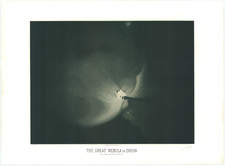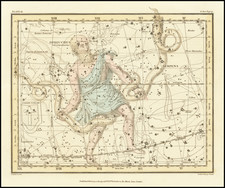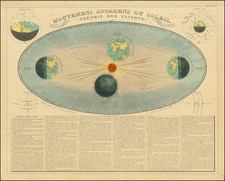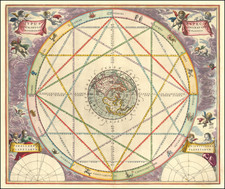The Ringed Planet as Portrayed by the Audubon of the Sky
This is a rare chromolithograph of Saturn from Etienne Leopold Trouvelot's original work depicting celestial bodies, published in 1882.
Trouvelot's portfolio is a work of artistic brilliance far ahead of its time; many of the plates are redolent of the most dramatic and engaging modernist paintings of the following century. In addition to its aesthetic qualities, it is a scientific work of great importance; Trouvelot's magnum opus stands a superlative celestial atlas and one of the most impressive American color plate books ever published.
The plates were lithographed by Armstrong and Company of Boston under Trouvelot's personal supervision. Some of the plates can be directly attributed to the lithographic artist E. Boyd Smith. An estimated 300 sets of the prints were sold as a portfolio for $125, although in a recent census only four complete sets of plates were found in institutions (see note on rarity). Trouvelot combined to a rare degree the qualities of an excellent observer and the skill of an accomplished artist. Solon Bailey stated: "Trouvelot made beautiful drawings of various other celestial objects, including total eclipses of the Sun, the surface of the moon, planets, comets and nebulae. These drawings show rare artistic ability."
As noted by Backhus and Fitch (p. 12):
To ensure exactness with his drawings, Trouvelot used a grid system positioned at the prime focus of his observing telescope. As a testimony to his accuracy relative to star positions, one analysis concludes that Trouvelot's drawings of star positions near the Orion nebula were within 6 arc seconds of actual star positions Trouvelot's first astronomical paper was published in 1875 in the Proceedings of the American Academy of Sciences on the topic of veiled solar spots.
Historian B.G. Corbin points out that an early form of astronomical photography became available during the time when Trouvelot was working, but that the artist rejected the idea of switching media, arguing that "the camera could not replace the human eye" when it came to capturing the subtleties of structure and configuration. Trouvelot himself noted:
Although photography renders valuable assistance to the astronomer in the case of the Sun and Moon... for other subjects, its products are in general so blurred and indistinct that no details of any great value can be secured. A well trained eye alone is capable of seizing the delicate details of structure and of configuration of the heavenly bodies, which are liable to be affected, and even rendered invisible, by the slightest changes in our atmosphere. (Trouvelot 1882, p. v).
The Dictionary of Scientific Biography notes:
Except for Rutherford's wet-plate photographs of the sun and moon, made in 1865, Trouvelot's drawings were considered the most accurate pictures of celestial objects available until the perfection of dry-plate photography. (DSB XIII, 472)
His artistic genius received wide acclaim, with examples of his drawings appearing for public display. For example, several drawings were displayed at the United States Centennial Exhibition in 1876 in Philadelphia as part of the Naval Observatory exhibit. It became apparent that the best way to reach a wider audience was to seek a publisher to produce a printed selection of his monumental works. Trouvelot decided to bring his drawings to the New York publisher Charles Scribner's Sons to be transformed into chromolithographs, a process he supervised closely.
The Sixth Planet from the Sun
Trouvelot's portrayal of Saturn is stunning. The rings of ice and dust can be clearly and attractively seen. These are visually unique in the solar system (though most of the giant planets have similar structures), of which the origins are still uncertain. Scientists still debate as to whether these are the remnants of a destroyed moon of Saturn or protoplanetary material that never amalgamated. The surface of Saturn itself is smoother and less violent than that of Jupiter, with its storms more temporary and transient in nature.
Saturn was the furthest planet from the sun for which any detail was available to astronomers in the 19th century. Uranus had been visible to the naked eye to the ancients, but mistaken for a fixed object, as had the Galilean discovery of Neptune. Further, these planets possess far fewer features due to their ice giant nature. As such, this portrayal of a planet 850 million miles away was the furthest object which could be portrayed accurately and at a (relatively) small scale.
Trouvelot describes the work and phenomenon as follows in his Trouvelot Astronomical Drawings Manual:
Saturn is unique amongst the planets in that its globe is encircled by a series of concentric rings which lie in the plane of its equator, and consist, according to present theories, of vast throngs of minute bodies revolving about the planet, like so many satellites, in closely parallel orbits. The globe of Saturn, like that of Jupiter, is surrounded by cloudy belts parallel to its equator. The broad equatorial belt, of a delicate pinkish tint, is both brighter and more mottled than the narrower yellowish white belts, which alternate with darker belts of ashy gray on both the north and south sides, but are seen here only on the northern side. The disk has an oval shape, owing to the extreme polar compression of the globe.
The outer, middle and inner rings, with their various subdivisions, are clearly shown in Plate X., and are best seen on the so-called ansæ, or handles, projecting on either side. The gray outer ring is separated by the dusky pencil line into two divisions, both of which appear slightly mottled on the ansæ, as if with clouds. The middle ring has three subdivisions which are clearly distinguishable, although separated by no dark interval, viz., a brilliant white outer zone, distinctly mottled, as seen on the extremities of the ansæ and two interior zones of gradually diminishing brightness. The gauze or dusky ring is seen at its full width on the ansæ, but on the background of the strongly illuminated globe only its outer and presumably denser border is visible. The shadow of the globe on the rings is seen on the lower portion of the eastern ansa. The shadow on the dusky ring is with difficulty perceptible; the shadow on the middle ring is slightly concave toward the planet, which concavity is abruptly increased on the outer zone of this ring; while the shadow on the outer ring slants away from the globe. These appearances are fully accounted for by supposing a general increase of level from the inner edge of the dusky ring to the outer margin of the middle ring, and a uniform lower level on the outer ring. Other observers have regarded the deflection of the shadow as an effect of irradiation. The inner margin of the double outer ring presents on both ansæ; a number of slight indentations, which, if not actual irregularities in the contour of this ring, may be explained as shadows caused by elevations on the outer border of the middle ring, or possibly by overhanging clouds.
Rarity
Trouvelot's prints were originally intended for the astronomical and scientific community and most of the larger US observatories purchased copies of the portfolio. In 2002, B.G. Corbin undertook a census to determine the number of surviving copies of the complete set of 15 prints and was only able to confirm the existence of 4 complete sets.
Trouvelot (1827-1895) was born in Guyencourt, Aisne, France. During his early years he was apparently involved in politics and had Republican leanings. Following a coup d'état by Louis Napoleon in 1852, he fled or was exiled with his family to the United States, arriving in 1855. They settled in the town of Medford, Massachusetts, where he worked as an artist and nature illustrator. In both 1860 and '70 census, his occupation is listed as lithographer.
Trouvelot had an interest as an amateur entomologist. In the U.S., silk-producing moths were being killed off by various diseases. Trouvelot brought some Gypsy Moth egg masses from Europe in late 1866 and was raising gypsy moth larvae in the forest behind his house. Trouvelot apparently understood the danger posed by the Gypsy Moths and housed them under netting. Unfortunately, an egg mass went missing during a storm in 1869. He immediately realized the potential problem he had caused and notified some nearby entomologists, but nothing was done. This story has been called into question, based on earlier reports Trouvelot made that his netting had holes in it large enough for robins to fit through and eat his caterpillars.
Shortly following this incident, Trouvelot lost interest in entomology and turned to astronomy. In this field he could put his skills as an artist to good use by illustrating his observations. His interest in astronomy was apparently aroused in 1870 when he witnessed several auroras.
When Joseph Winlock, the director of Harvard College Observatory, saw the quality of his illustrations, he invited Trouvelot onto their staff in 1872. In 1875, he was invited to the U.S. Naval Observatory to use the 26-inch refractor for a year. During the course of his life he produced about 7,000 quality astronomical illustrations. 15 of his most superb pastel illustrations were published by Charles Scribner's Sons in 1881. He was particularly interested in the Sun, and discovered "veiled spots" in 1875. Besides his illustrations, he published about 50 scientific papers.
In 1878, Trouvelot and his son traveled to Creston, Wyoming Territory, to observe the total eclipse of the Sun on July 29.
By 1882, Trouvelot had returned to France and joined the Meudon Observatory. He worked there under Jules Janssen, a leading solar astronomer. However, Trouvelot resented the cloudy French sky, which impeded his observations. He traveled with Janssen to the Caroline Islands in the South Pacific to observe the total eclipse of 1883 and attempt to discover the phantom intra-Mercurial planet.
Trouvelot died at Meudon on April 22, 1895. At the time he was working on a monograph of Mars. His son, George, hoped to find a publisher for Etienne's drawings of Mars, but was unsuccessful. The whereabouts of almost all of the drawings left by Trouvelot to his family are currently unknown.











![Sphere Droite [and] Sphere Parallele](https://storage.googleapis.com/raremaps/img/small/6208.jpg)


![[Virgo]](https://storage.googleapis.com/raremaps/img/small/79551.jpg)